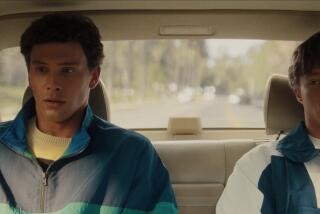Movie Review : Dreamy Confrontation in Freddy’s Family
- Share via
“A Nightmare on Elm Street 5: The Dream Child” (citywide) has the effect of a relentless undertow, trapping its young people in a grisly fantasy of supernatural terror masterminded by the unconquerable Freddy Krueger. In only his second feature, Australian director Stephen Hopkins, whose background includes comic illustration and set design, has created a dynamic, fully visually realized experience. It’s every bit as gory as “Batman” but more cohesive and its struggle between good and evil more tightly integrated.
Lisa Wilcox’s blonde, tenacious Alice returns from the fourth film to do battle with Freddy all over again. As virtually every teen-ager could tell you, Freddy Krueger was a crazed child-killer who was burned alive by the parents of his victims but who returned in the dreams of a fresh crop of young people to wreak more deadly havoc. The way he returns this time is ingenious: in the dreams of the Alice’s unborn child, which finally involves a confrontation with Freddy’s own mother. The film works its way through some splendidly scary nightmares to achieve an aura of redemption more spiritual than you would think possible in a no-holds-barred exploitation picture.
Right from the start the film, written by Leslie Bohem and rightly R-rated, announces its originality: Just as we think we’re being asked to watch yet another homage to “Psycho’s” shower scene, the sequence takes off in an entirely unexpected direction. One of Alice’s friends is a gifted cartoonist (Joe Seely), which allows for some inspired art direction and use of animation and also serves to underline the notion that no comic-book hero stands a chance in the face of true evil.
In creating a film that has images reminiscent of “The Cabinet of Dr. Caligari” as well as “Metropolis,” Hopkins and Bohem have had a major assist from production designer C. J. Strawn, whose work in the fantasy sequences has much the witty and stylized quality of Michael Riva’s complex and whimsical constructions for “The Adventures of Buckaroo Banzai,” and from visual effects supervisor Alan Munro. Cinematographer Peter Levy and editors Chuck Weiss and Brent Schoenfeld, and surely many others as well, have contributed virtuoso work.
Robert Englund is a gleeful Freddy, that mass of scar tissue with five mini-scythes in place of fingers on his right hand. Wilcox, Seely, Kelly Joe Minter and other young actors do well playing roles in which they must constantly despair of trying to get their elders to believe in the seemingly impossible. More and more, Freddy emerges as a symbol of the irrational world that awaits youngsters, who must find within themselves the courage to conquer it. Clearly, we haven’t seen the last of Krueger.
More to Read
Only good movies
Get the Indie Focus newsletter, Mark Olsen's weekly guide to the world of cinema.
You may occasionally receive promotional content from the Los Angeles Times.








